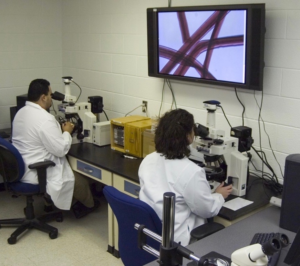The infamous labor leader, and president of the International Brotherhood of Teamsters from 1958 to 1971, mysteriously vanished on July 30, 1975.
Because of the union’s close ties to organized crime, Hoffa had gained more power, but was also linked to some shady practices. Hoffa was sentenced to prison for thirteen years for jury tampering, mail fraud, and bribery, but was pardoned by President Richard Nixon in 1971 on the condition that he would not stay involved with union activities. Even so, by the time of his disappearance Hoffa had already begun trying to rebuild his Teamster support base in Detroit, angering those who had come to power in his absence.
Despite the hundreds of wild theories about what happened to Jimmy Hoffa, only a handful of details about his disappearance have actually been confirmed. On July 30, 1975, Hoffa left his home in his green Pontiac Grand Ville to meet two fellow mobsters, Anthony Giacalone and Anthony Provenzano, at the Machus Red Fox Restaurant at 2:00 p.m. Shortly after, Hoffa called his wife to say that they hadn’t shown up yet. When Hoffa did not return home, his wife reported him missing. His car was found at the restaurant with no sign of where Hoffa had gone. The last person to see him alive was a truck driver, who reported seeing Hoffa riding with several other unidentified men in a Mercury Marquis that nearly collided with his truck as it left the Red Fox. The description of the vehicle perfectly matched one owned by Anthony Giacalone’s son that was being used by Hoffa’s friend Chuckie O’Brien at the time. Already suspicious of O’Brien due to recent tiffs with Hoffa, authorities seized the vehicle on August 21. Search dogs detected Hoffa’s scent inside but no other evidence was found. This is where the trail went cold. By 1982, the FBI declared Hoffa dead, still without any idea where his remains were located.

A handful of other sites were searched in the following years, including a horse farm and under a former mobster’s garage, but turned up nothing. The FBI has said the most probable explanation is that the new Teamster leadership ordered a hit on Hoffa to prevent his return to power in union politics. It is extremely unlikely at this point that his body will ever be found.
The public continues to remain fascinated by the disappearance. The gritty allure of the mafia underworld and wild conspiracy theories have fueled references about Jimmy Hoffa’s disappearance in pop culture to this day. In 2006, the FBI released the official comprehensive casefile from 1976 (known as the Hoffex Memo), stoking the world’s interest all over again. Leads continue to be presented and explored by the FBI, but they are still no closer to finding out what really happened to Hoffa on July 30.
In an interesting bookend, Hoffa’s son, James Hoffa, became president of the International Teamsters in 1998.
Back to Crime Library
|
|
|
